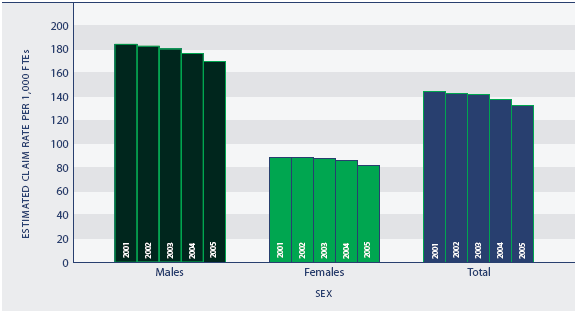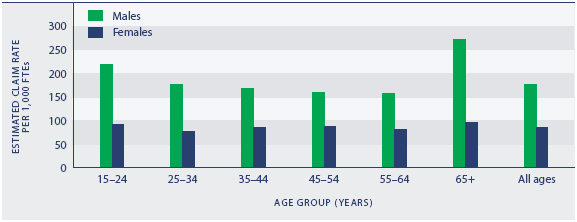Workplace injury claims
Definition
The number of workplace accident insurance claims reported to the Accident Compensation Corporation (ACC) per 1,000 full-time equivalent employees, excluding those employees who received accident and emergency treatment only.
Relevance
Safety at work is an important contributor to wellbeing and the risk of work-related accidents or illness can be seen as one component of the quality of work. The best currently available measure of the incidence of workplace injuries comes from the database of claims made to the ACC.
Current level and trends
Provisional data for the 2005 calendar year shows 242,600 work-related injury claims had been reported to the ACC by 31 March 2006. This represents a rate of 132 claims per 1,000 full-time equivalent employees (FTEs), lower than the rate in the previous year (138 per 1,000 FTEs). The majority of claims were for medical treatment only (ie not including weekly compensation). Eighty-three percent of the claims were for employees, and people who employed others in their own business. The other 17 percent were for the self-employed who did not employ others in their business. The injury claim rate for self-employed not employing others was much higher than for the rest of the workforce (203 per 1,000 FTEs compared with 123 per 1,000 FTEs).
Figure PW4.1 Estimated claim rate per 1,000 FTEs, by sex, 2001–2005

Source: Statistics New Zealand (2006a)
Note: 2005 data is provisional and subject to change
Injury claims reported by March 2006 for the year ended December 2005 included 86 work-related fatalities, 8 fewer than the 94 reported in 2003.51 This is likely to be an underestimation of the final number of fatalities, because some workers may have died later from injuries in the period, and not all fatal work-related accidents result in a claim to the ACC. In 2005, construction and agriculture each accounted for 23 percent of work-related fatalities, followed by manufacturing (19 percent) and transport and storage (16 percent).
Age and sex differences
Males are more than twice as likely as females to suffer workplace injuries involving a claim to the ACC (170 per 1,000 FTEs for males compared with 81 per 1,000 FTEs for females). This reflects in part a male predominance in relatively dangerous occupations (eg elementary occupations and plant and machine operating and assembly occupations, where the injury claim rates are 287 and 245 per 1,000 FTEs, respectively). The highest rate for males was for those aged 65 years and over followed by those aged under 25 years. Age differences in the injury claim rate for females were less pronounced.
Figure PW4.2 Estimated claim rate per 1,000 FTEs, by age and sex, 2005

Source: Statistics New Zealand (2006a)
Note: 2005 data is provisional and subject to change
Ethnic differences
Workplace injury claim rates are higher for Māori (182 per 1,000 FTEs) than for other ethnic groups. In 2005, the next highest rate was for Pacific peoples (158 per 1,000 FTEs), followed by Europeans (119 per 1,000 FTEs). The Other ethnic group has the lowest accident claim rate (114 per 1,000 FTEs).
Table PW4.1 Workplace injury claims, by ethnicity, 2005
| Ethnic group |
Number of claims |
Rate per 1,000 FTEs |
| European |
169,300 |
119 |
| Māori |
30,700 |
182 |
| Pacific peoples |
12,700 |
158 |
| Other |
18,800 |
114 |
| Total |
242,600 |
132 |
Source: Statistics New Zealand (2006a)
Notes: (1) Data is provisional (2) Other includes Asian (3) Total includes ethnicity not specified
Regional differences
The highest work-related injury claim rates were in the Bay of Plenty and Gisborne/Hawke’s Bay, with rates of 197 and 180 claims per 1,000 FTEs, respectively. Wellington had the lowest rate of 74 claims per 1,000 FTEs (the only region with an incidence rate below 100).
Industry differences
Injury claim rates are highest in the primary industries of mining (198 claims per 1,000 FTEs), and in agriculture, forestry and fishing (190 per 1,000 FTEs). However, there are also relatively high rates in manufacturing (169 per 1,000 FTEs) and in construction (167 per 1,000 FTEs), which together employ about a quarter of all FTEs. The lowest injury claim rate is for people working in finance and insurance (22 per 1,000 FTEs).
|


